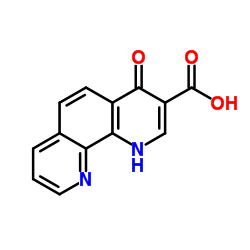331830-20-7
| Name | 4-oxo-1,4-dihydro-[1,10]phenanthroline-3-carboxylic acid |
|---|---|
| Synonyms |
1,10-phenanthroline-3-carboxylic acid, 4-hydroxy-
T B666 CN NNJ EVQ FQ 1,4-Dihydro-4-oxo-1,10-phenanthroline-3-carboxylic acid 1,10-Phenanthroline-3-carboxylic acid, 1,4-dihydro-4-oxo- 4-Hydroxy-1,10-phenanthroline-3-carboxylic acid T B666 CM FV NNJ EVQ 4-Oxo-1,4-dihydro-1,10-phenanthroline-3-carboxylic acid 4-Oxo-1,4-dihydro-[1,10]phenanthroline-3-carboxylic acid 1,4-dpca MFCD07357380 |
| Description | 1,4-DPCA, a potent prolyl-4-hydroxylase inhibitor, is a collagen hydroxylation inhibitor in human foreskin fibroblasts with an IC50 of 2.4 µM. 1,4-DPCA inhibits prolyl-4-hydroxylases α isoforms stabilizes HIF-1α protein. 1,4-DPCA also inhibits factor inhibiting HIF (FIH) with an IC50 of 60 μM[1][2]. |
|---|---|
| Related Catalog | |
| Target |
IC50: 2.4 µM (Collagen hydroxylation); 60 μM (Factor inhibiting HIF (FIH))[2] |
| In Vitro | 1,4-DPCA (24 hours) treatment specifically increases the expression of multiple target genes, including the proangiogenic target genes Vegfa and Hmox1 and proglycolytic targets Ldh-a, Pgk1, Pdk1, and Glut1 in mouse B6 cells[1]. 1,4-DPCA treatment significantly reduces the colony sizes of T4-2 (10 μM 1,4-DPCA) and ZR-75-1 cells (20 μM 1,4-DPCA). 1,4-DPCA-treated T4-2 cells form polarized spheroids in 3D culture. 1,4-DPCA treatment significantly reduces invasive branches in DA-MB-157 (20 μM 1,4-DPCA) and MDA-MB-231 (10 μM 1,4-DPCA) cells.1,4-DPCA inhibits the proliferation of T4-2, ZR-75-1, MDA-MB-157 and MDA-MB-231 cells[3]. |
| In Vivo | 1,4-DPCA treatment suppresses connective tissue ingrowth in porous porous poly (lactic-co-glycolic acid) (PLGA) discs implanted in the peritoneal cavity for 28 days in mice. 1,4-DPCA is found to be effective at inhibiting collagen deposition within and on the outer surface of the disc, and also limited connective tissue ingrowth, but not to the extent of glucocorticoid inhibition[2]. |
| References |
| Density | 1.5±0.1 g/cm3 |
|---|---|
| Boiling Point | 474.5±45.0 °C at 760 mmHg |
| Molecular Formula | C13H8N2O3 |
| Molecular Weight | 240.214 |
| Flash Point | 240.8±28.7 °C |
| Exact Mass | 240.053497 |
| PSA | 83.05000 |
| LogP | 3.28 |
| Vapour Pressure | 0.0±1.2 mmHg at 25°C |
| Index of Refraction | 1.727 |
| HS Code | 2933990090 |
|---|
| HS Code | 2933990090 |
|---|---|
| Summary | 2933990090. heterocyclic compounds with nitrogen hetero-atom(s) only. VAT:17.0%. Tax rebate rate:13.0%. . MFN tariff:6.5%. General tariff:20.0% |
